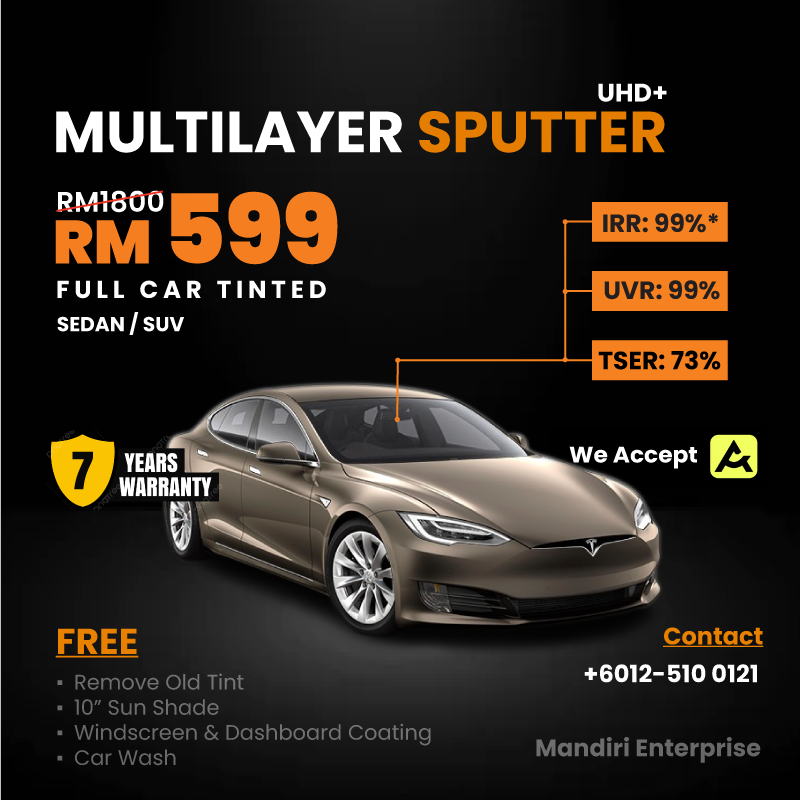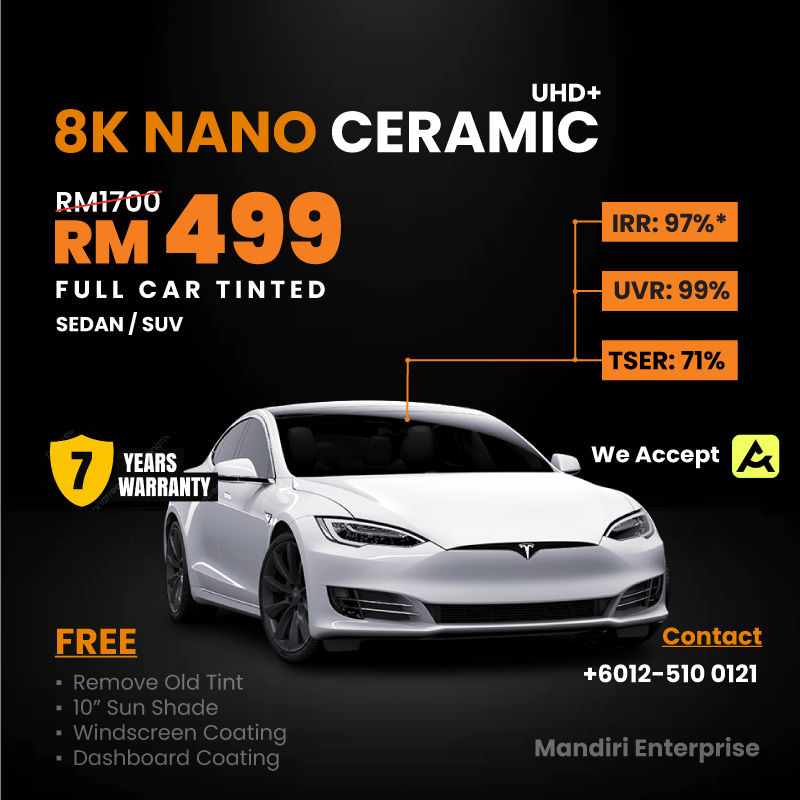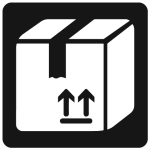MULTILAYER SPUTTER UHD TINT
What is Multilayer Sputter UHD Tint?
Multilayer : This tint content multiple layers (15 layers) of sputtering materials. That’s why it called multilayer. (Note: even it content multiple layers material, still it’s thickness remain 2mil).
Sputter: This refers to the advanced manufacturing process called magnetron sputtering, where metallic particles are precisely deposited onto polyester film in a vacuum chamber. This creates a nano-scale coating that’s exceptionally durable and uniform.
UHD (Ultra High Definition): Indicates the film’s optical clarity, which maintains near-perfect visual transparency with minimal distortion or haze – crucial for high-resolution displays and preserving scenic views.
IRR or Infrared Ray Rejection Value : 99%
The infrared (IR) rejection rate of Multilayer Sputter UHD tint ranges from 98% to 99%, with minor variations (±1%) between production batches.
Infrared Rejection (IRR) by VLT Grade
| VLT (Visible Light Transmission) | IRR (Infrared Rejection) | Tolerance |
|---|---|---|
| 5% (Limo Black) | 99% | ±1% |
| 15% (Dark Smoke) | 99% | ±1% |
| 35% (Medium Smoke) | 99% | ±1% |
| 50% (Light Smoke) | 99% | ±1% |
| 70% (High Clarity) | 98% | ±1% |
UVR or Ultraviolet Rejection Value : 99%
The ultraviolet (UVR) rejection rate of Multilayer Sputter UHD tint is 99%. Even darkness is different but UVR is same 99% or more
UV Rejection Performance
| VLT Grade | Visible Light Transmission | UV Rejection (UVR) |
|---|---|---|
| 05% | Limo Darkness | 99%+ |
| 15% | Dark Smoke | 99%+ |
| 35% | Medium Smoke | 99%+ |
| 50% | Light Smoke | 99%+ |
| 70% | High Clarity | 99%+ |
Key Features:
✅ Consistent 99%+ UV Block – Regardless of tint darkness
✅ Full Spectrum Protection – Blocks both UVA (315-400nm) and UVB (280-315nm)
✅ Non-Negotiable Safety – Meets international skin cancer prevention standards
VLT or Visible Light Transmission / Darkness
VLT or visible light transmission mean the percentage of light can go throw the tint. VLT is opposite of darkness. Example; if VLT is 05%, the darkness will be 95%
What VLT Means:
VLT = % of visible light (380-700nm) that passes through the tint
-
Lower VLT = Darker tint (more light blocked)
-
Higher VLT = Lighter tint (more light transmitted)
Product’s VLT Options:
| VLT % | Darkness % | Common Name | Best Use Cases |
|---|---|---|---|
| 5% | 95% | Limo Black | Maximum privacy, luxury vehicles |
| 15% | 85% | Dark Smoke | Privacy with some visibility |
| 35% | 65% | Medium Smoke | Balanced privacy/visibility |
| 50% | 50% | Light Smoke | UV/heat rejection + clarity |
| 70% | 30% | High Clarity | Maximum visibility + UV protection |
TSER or Total Solar Energy Rejection : 73%
TSER (Total Solar Energy Rejected) is a key performance metric for window films (including Multilayer Sputter UHD Tint) that measures the percentage of total solar energy (heat) blocked by the film. It accounts for:
-
Infrared (IR) Rejection
-
UV Rejection
-
Visible Light Absorption/Reflection
Formula:
TSER = (Reflected Solar Energy + Absorbed Solar Energy) ÷ Total Incident Solar Energy
Why It Matters:
-
A higher TSER (%) means better heat reduction.
-
Example: A film with 80% TSER rejects 80% of the sun’s heat energy.
-
Differs from IR rejection (which only measures infrared heat).
Typical TSER Values:
-
Standard dyed films: 30–50% TSER
-
Metallized/Ceramic films (e.g., Multilayer Sputter UHD): 50–80% TSER
Key Note:
TSER depends on the film’s VLT (Visible Light Transmission). Darker films (lower VLT) usually have higher TSER but reduce natural light.
Thickness : 2mil
Even the multilayer sputter tint content multiple layers material, still it’s thickness 2mil (standard 50.8 microns )
Suggestion: If you’re looking for a high heat rejection sputter film with safety features, you can check our package “Sputter + Safety Tint”.
Warranty Terms for Multilayer Sputter Tint
Coverage Period:
✅ 7 Years – Comprehensive protection for defects and performance.
What’s Covered:
-
Manufacturing Defects:
-
Bubbling, peeling, or delamination.
-
Cracking
-
-
Aesthetic Integrity:
-
Color fade/discoloration beyond acceptable standards.
-
Hazing or loss of optical clarity.
-
Performance Warranty:
-
Infrared Rejection (IRR) & UV Rejection (UVR):
-
Guaranteed to maintain minimum 90% of original performance (e.g., 90% UVR → remains ≥81%).
-
10% tolerance allowed for batch variations and testing methods.
-
What’s Not Covered:
-
Damage from glass breakage, or aftermarket cleaning chemicals.
Difference : Multilayer Sputter Tint vs. Nano Ceramic Tint
Multilayer Sputter Tint vs. Nano Ceramic Tint
(Key Differences in Heat Rejection & Performance)
| Feature | Multilayer Sputter Tint | Nano Ceramic Tint |
|---|---|---|
| IR Rejection (IRR) | 99% | 95–97% |
| UV Rejection (UVR) | 99%+ (All VLT levels) | 99%+ (Same) |
| Technology | 15+ layers of sputtered metals/oxides | Non-metallic ceramic particles |
| Heat Rejection | Superior (TSER 73%) | Very Good (TSER 71%) |
| Durability | 7+ years (Oxidation-resistant) | 7 (Durable but non-metallic) |
| Signal Interference | Possible (Metallic layers) | None (5G/GPS friendly) |
| Clarity/Reflectivity | Slight mirror effect (depends on VLT) | Zero reflectivity (True matte) |
| Thickness | 2 mil | 2 mil |
| Best For | Extreme heat climates | No-signal zones |
Which to Choose?
Multilayer Sputter Tint (99% IRR)
✅ When you need:
-
Maximum heat rejection (desert/hot climates)
-
Longer warranty (7–10 years typical)
-
Slightly better durability
Nano Ceramic Tint (95–97% IRR)
✅ When you prefer:
-
No signal interference (SmartTag)
-
Matte finish (no metallic shine)






